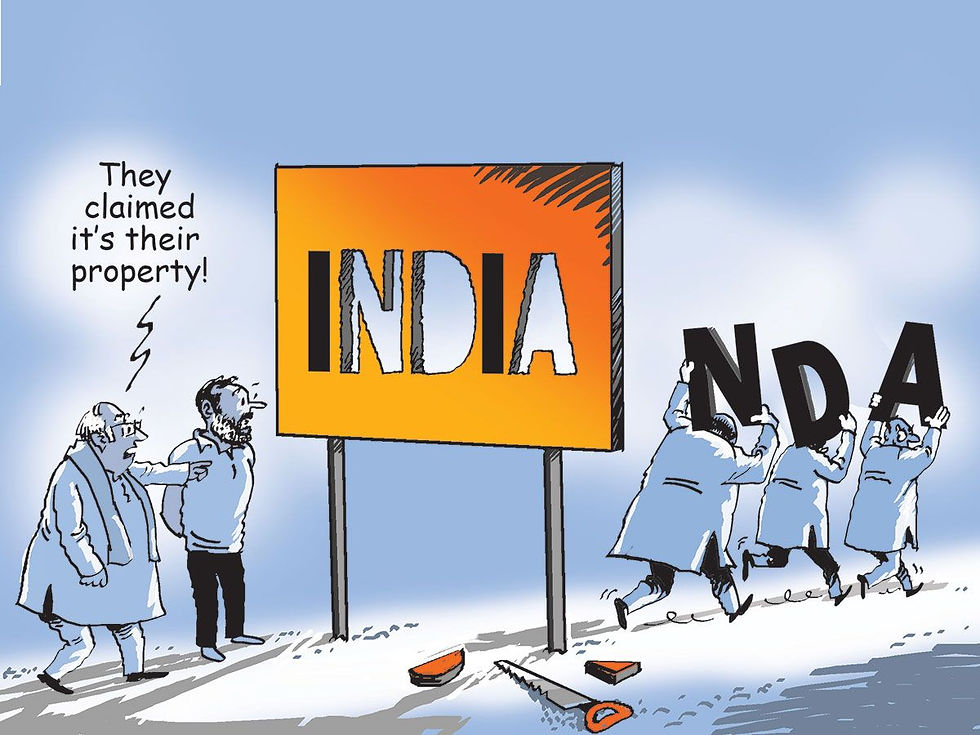The Changing Dynamics of Indian Politics: NDA vs I.N.D.I.A
- Uma Parashar
- Aug 31, 2023
- 3 min read
Introduction:
In the world's largest democracy, Indian politics has always been known for its fierce competition and ideological differences between political parties. However, the year leading up to the 2024 elections witnessed a surprising shift in dynamics as rival parties discovered common ground and came together under the banner of I.N.D.I.A. This unprecedented unity has created an intriguing scenario, pitting a united front against the incumbent leader and NDA's chosen candidate, Narendra Modi. As citizens and voters, it becomes crucial for us to assess the choices before us and make an informed decision based on each party's vision for the future.

The Formation of I.N.D.I.A:
Despite their historical animosity, Indian political parties realized the need to put aside their differences and unite for the greater good of the nation. The acronym "I.N.D.I.A." represents this newfound unity, standing for "Indian, National, Development, Inclusivity, and Alliance." This alliance seeks to move beyond individual agendas and work collectively towards the progress and development of India under one party mindset.
The Rise of Rahul Gandhi and the Opposition:
With the formation of I.N.D.I.A., the opposition party found a renewed sense of purpose. Rahul Gandhi, a prominent figure within the party, gained popularity as the potential candidate for Prime Minister. However, scepticism surrounds Gandhi's leadership abilities, with many perceiving him as lacking in experience and decisiveness.
A Vision for Development:
On the other hand, the NDA, led by incumbent Prime Minister Narendra Modi, presents a vision rooted in development and progress. Modi's tenure has seen significant infrastructural advancements, economic reforms, and social welfare initiatives. The NDA government's commitment to these policies has garnered both national and international recognition, and they are keen to continue this trajectory.
The Importance of Making an Informed Choice:
As responsible citizens, choosing the right leader is a vital task. We must carefully evaluate each party's vision, priorities, and track records to make an informed decision. While party alliances can bring about much-needed unity, it is crucial to look beyond these alliances and focus on the qualities and capabilities of individual leaders and most important to keep development in view.
Analysing the Potential Leaders:
Narendra Modi, who has held the reins of power since 2014, has demonstrated his ability to drive the nation forward. His emphasis on economic growth, job creation, and sustainable development has resonated with millions of Indians. However, critics argue that certain sections of society have been left behind, raising questions regarding inclusivity.

Rahul Gandhi, despite his lineage, still lacks the experience and proven track record to instil confidence in all voters. However, his party's unity under the I.N.D.I.A. alliance provides him with a support system that could help address these concerns and facilitate his growth as a leader or youth leader at his age of 53. Conclusion: The unity displayed by the formation of I.N.D.I.A. is undoubtedly a turning point in Indian politics. It signifies a collective effort setting aside previous differences just to defeat one person for satisfying their piled up ego. As we approach the 2024 elections, we, as citizens, must critically examine the competing visions and choose a leader who embodies our aspirations for a prosperous, inclusive, and sustainable India. Ultimately, the decision lies in our hands, and it is our duty to make an informed choice that will shape the future of our beloved nation. Be Nice, Vote wise !







Good Review.. keep going...
Nice